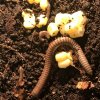- Joined
- Apr 29, 2015
- Messages
- 1,330
That's exactly what it is a slow release fertilizer pellet found in topsoil/compost bags. I've found it in my bags I use for T's.The 'egg' looks like a fertilizer pellet...
Those are nice Thai rainbows! However, I'm not so sure of the difference between Tonkinbolus dollfusi, T. adolphii, Apuethes sp., and Aulacobolus sp. They all look similar, except for dollfusi.


